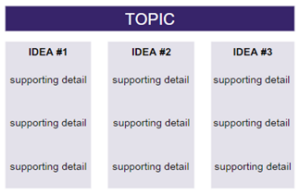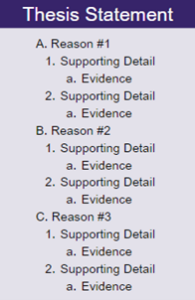How to Get Started on Different Types of Writing Assignments
When faced with writing an essay, story, or another type of writing assignment, students and writers alike may feel lost on where to begin. This is especially true when the prompt is too vague or too complex. Below, we will explore different ways to get started on writing assignments based on the genre of writing.
If you have a prompt (for any type of writing), remember to do the following:
-
- Read the prompt carefully.
- Underline any keywords or key phrases and any action words.
- Rephrase the prompt or the main question in your own words.
Clarifying the prompt is an important first step in getting started on any piece of writing. Yet, let’s dive into starting different types of writing assignments: informational, narrative, and persuasive writing.
Getting Started on Informational Writing
Informational writing is based on facts and only facts. It does not make a stance or defend an opinion.
Brainstorming for Informational Writing
If you are given a prompt, make sure you examine it closely as described above.
If you don’t have a prompt, you will have to choose a topic. Start with your hobbies, passions, or interests. These can be topics, activities, or anything! Your best expository writing will be related to things you care about.
-
- Listing: set a timer and write down as many bullet points as possible within the allotted time
- Freewriting: write any thought or idea about the prompt in paragraph form
Both brainstorming methods above work for narrative and persuasive writing as well. If you still are finding yourself stuck while brainstorming, check out this list of free online writing games that we compiled to get your creativity flowing.
Planning Informational Writing
One of the most important parts of planning an informational essay is doing research and organizing notes.
For a typical five-paragraph essay, there will be an introduction, three body paragraphs (each with one main point), and a conclusion.
Once you have your topic, brainstorm three supporting or relevant ideas, and decide on the main points of your body paragraphs.
Then, you can organize your ideas and research underneath each main point as supporting details.
Drafting Informational Writing
For essays of any genre, you’ll want the first line to pull readers in and keep them reading. That is done by using a hook, or a beginning that makes your readers want to read on. Try doing one of the following:
-
- Asking a rhetorical question
- Stating a fact
- Quoting an expert in the field or a well-known figure
- Relaying an anecdote
- Giving an interesting or remarkable statistic
- Defining a relevant term
- Describing a scene that is relevant to the topic
Each of the approaches above is a great way to begin an informational essay. Be sure to cater your opening to the topic of the essay to ensure that the writing is focused.
Getting Started on Narrative Writing
In essence, a narrative is a story; the author or narrator tells the tale of a series of events. To write a narrative, first know whether you are writing fiction (a made-up story) or nonfiction (a true story).
If you are fully stuck and there is no specific prompt to follow, search online for a list of writing prompts. A Grade Ahead even has a list of spooky writing prompts or a Spring writing prompt!
Brainstorming for Narrative Writing
There are quite a few ways to brainstorm for a fiction or nonfiction story. If there is a prompt, be sure to consider the constraints of the prompt while brainstorming.
One method that is useful for narrative writing brainstorming is visual mapping or webbing, and it is especially helpful for fictional stories. Essentially, write ideas for plot events, characters, settings, conflicts, and resolutions with a box or circle around them and connect using lines. The lines drawn should connect relevant ideas to each other or
connect chronological plot points. There could be multiple possibilities for what could happen next in the visual map. See the example given for an idea of how this could look.
You can learn more about these brainstorming practices in A Grade Ahead’s English curriculum, especially our special 8th-grade English three-month writing section and one of our camps: Time Traveler Tales, which combines both history and writing.
Planning Narrative Writing
Narrative writing focuses on creativity, so planning for narratives is the perfect time to flex those imaginations. Try one of the methods below to organize story events.
-
- Storyboards: Draw the scenes from your story and write some dialogue in a rectangle or square like a comic. Having a drawing of the scene may unlock new ideas or show what could happen next. If you have the squares cut out, you can rearrange them and add new ones as the story evolves.
- Sticky Notes: Write one plot event on each sticky note and organize them in order on your desk or another work surface. This makes it easy to add, remove, order, and replace scenes as needed to get your overall plot determined – with no artistic skills required!
Drafting Narrative Writing
Narrative writing differs from other types of writing in that it may lack a clear introduction. In fact, one of the most well-known pieces of narrative writing advice is to start the story with action. It’s important to get the readers interested right away and keep them interested. With the plot events in mind, consider doing one of the following to start your narrative essay.
-
- Begin with action: start with a character doing something active or with something intense happening.
- Begin with dialogue: show the personality of a character by starting with their words.
- Ask a question: get readers thinking by starting with a question.
- Paint a picture: describe the setting of your story using vivid language and imagery.
- Give background information: include at least one detail meant to make the readers curious.
- Introduce a character: try to surprise the readers in some way.
Getting Started on Persuasive Writing
In general, argumentative writing uses reasoning and evidence to show the validity of claims to an audience. Persuasive writing is more focused on convincing the audience to join in the same thinking, whereas other types of argumentative writing can be a little more analytical or unbiased.
Brainstorming for Persuasive Writing
There are multiple ways to brainstorm for a persuasive essay. In fact, the methods listed in narrative and informative writing are all applicable to persuasive writing as well. However, one specific way to brainstorm that helps narrow down persuasive topics is the question method. Asking yourself questions and answering them can be a strong way to find your main argument.
If you do not have a prompt, consider the following:
-
- What is important to me?
- What is a change I’d like to see in my community or the world?
- What is a problem that needs to be addressed?
- What do I argue for or debate in my regular conversations?
Once you get a topic, or if you have a topic from a prompt, you may want to ask yourself some of these questions:
-
- What is my main point?
- Who is my audience?
- What are the reasons to agree with my argument?
- What are the reasons to disagree with my argument?

Planning Persuasive Writing
Persuasive writing can really benefit from making an outline, which allows you to organize your essay by claims supported by evidence. To fill out a full outline, research may need to be completed.
See the example of an outline for a persuasive essay. There are three main reasons to support the thesis statement, and each reason has its own supporting details with evidence.
Remember that evidence will be facts, statistics, quotes, examples, analogies, or other types of support that confirm the detail given.
Drafting Persuasive Writing
In a persuasive essay, a hook and a thesis statement will make up most of the introduction. Be sure to write your thesis statement before drafting. Your thesis statement declares your main claim, can be argued, uses strong language, and previews the reasons found in the body paragraphs.
Then, use your outline to write your body paragraphs. If you’re struggling to complete a strong draft, check out our tips on how to improve writing.
In general, writing consists of some planning, drafting, and editing. Sometimes getting started is the hardest obstacle to tackle, so these ways to get started on different types of writing will certainly be a helpful source to reference the next time your student needs help with a writing assignment. And if your child needs more help with writing, consider an enrichment program like A Grade Ahead.
Author: Brenna Waugaman-Szalinski, Curriculum Coordinator at A Grade Ahead

One response to “The “Write” Way”